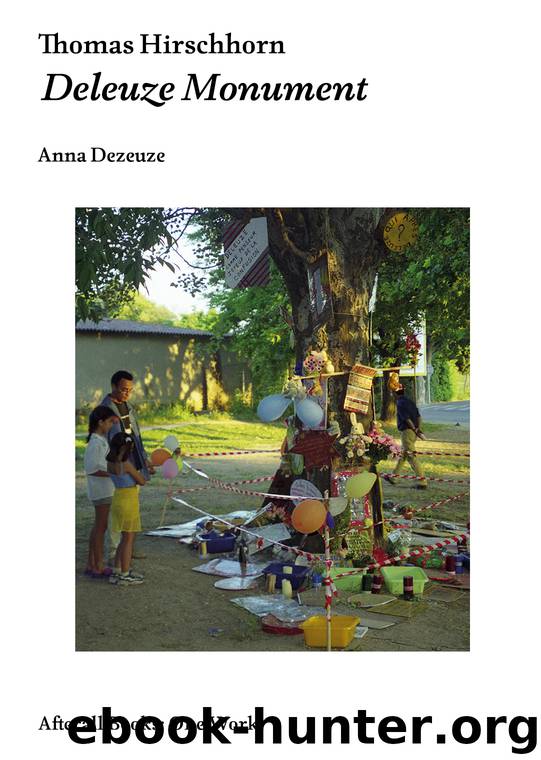Thomas Hirschhorn by Anna Dezeuze

Author:Anna Dezeuze [Anna Dezeuze]
Language: eng
Format: epub
Publisher: The MIT Press
Published: 2014-07-10T04:00:00+00:00
Murmurs in the Cité
Prior to Deleuze Monument, Hirschhorn’s only work in a French cité had been La Redoute (1991), in which the artist had displayed 55 of his works placing them on each floor of a tower block of La Redoute HLM (Habitation à Loyer Modéré, as public housing in France is called) during a group exhibition in the banlieue of Fontenay sous Bois.123 Six years earlier, British artist Stephen Willats had similarly exhibited text-and-photograph panels next to the elevators of each of the twenty floors of Brentford Towers, a tower block in the Green Dragon Lane Estate in West London. Each panel in Willats’s Brentford Towers (1985) included photographs and citations from discussions recorded between the artist and fifteen residents over a period of time, concerning objects that held a particular significance to them and objects that they could see from their windows. Such discussions and display panels aimed at encouraging a wider interaction among residents, resulting in the common resolution of practical problems as well as a general coming together.124 Similarly, the Danish collective Superflex sought to facilitate exchanges among residents of Coronation Court housing estate in Liverpool in 2000 (fig.34), by providing training, a television recording studio and access to (and publicity through) the artists’ internet platform (the Superchannel server). The residents ended up setting up their own station, Tenantspin.125
A 1993 exhibition, ‘PROJECT UNITE’, brought together a number of artists in another apartment block, the run-down Unité d’Habitation built by Le Corbusier in Firminy in France’s Loire region, largely inhabited by a working-class Algerian immigrant population. For this exhibition, artist duo Clegg & Guttmann asked each resident of the building to donate tapes of their favourite music, photographed each of them for the cover of their chosen tape and displayed each cassette in the corresponding apartment of an architectural model of the modernist Unité d’Habitation. The Firminy Music Library aspired to create what the artists called a ‘community portrait’ – an ambition that could also be ascribed to Willats’s Brentford Towers as well as to Superflex’s Superchannel.126 Within ‘PROJECT UNITE’, Clegg & Guttmann stood out in their adoption of a ‘quasi-anthropological scenario’, as Hal Foster has described it.127
With Deleuze Monument, Hirschhorn shared with Willats, Superflex and Clegg & Guttmann a desire to engage over a period of time with local residents of a specific low-income housing development by introducing art as a live presence within their daily space and experiences, thus overcoming the traditional division between a gallery-going audience and those who are not usually in contact with contemporary art. Moreover, Hirschhorn similarly sought to encourage interactions amongst residents by locating Deleuze Monument outside, and thus opening up communal spaces in which individuals could meet, talk and watch videos. (Such spaces also appear to be similar in their conviviality to those set up by ‘relational’ artists defended by Bourriaud.) The central differences, however, between Deleuze Monument and the participatory projects by Willats, Superflex and Clegg & Guttmann concern how Hirschhorn was never interested in creating a community
Download
This site does not store any files on its server. We only index and link to content provided by other sites. Please contact the content providers to delete copyright contents if any and email us, we'll remove relevant links or contents immediately.
You & Me & Why We Are in Love by Aurelia Alcaïs(3184)
The Four Agreements: A Practical Guide to Personal Freedom (A Toltec Wisdom Book) by Ruiz Don Miguel(2435)
7-14 Days by Noah Waters(2361)
Things Are What You Make of Them: Life Advice for Creatives by Adam J. Kurtz(1820)
Wall and Piece by Banksy(1781)
Post-Impressionism by Nathalia Brodskaya(1677)
Hieronymus Bosch by Virginia Pitts Rembert(1634)
The Thibaults by Roger Martin Du Gard(1571)
The Notebooks of Leonardo Da Vinci by Da Vinci Leonardo(1569)
The Andy Warhol Diaries by Andy Warhol(1563)
Design as Art by Bruno Munari(1556)
The Andy Warhol Diaries by Andy Warhol & Pat Hackett(1517)
Picasso by Gertrude Stein(1507)
Modeling the Head in Clay by Bruno Lucchesi(1482)
Delphi Complete Works of Vincent van Gogh by Vincent van Gogh(1453)
Memory's Wake by Fenech Selina(1442)
Delphi Complete Works of Artemisia Gentileschi (Illustrated) by Artemisia Gentileschi(1441)
Auguste Rodin by Rainer Maria Rilke(1363)
South by Ernest Henry Shackleton(1360)
